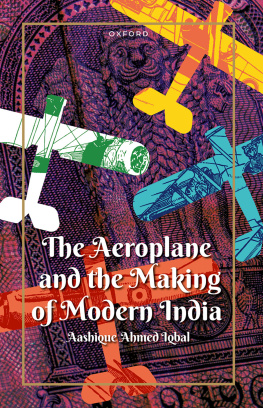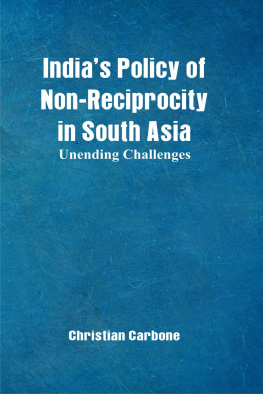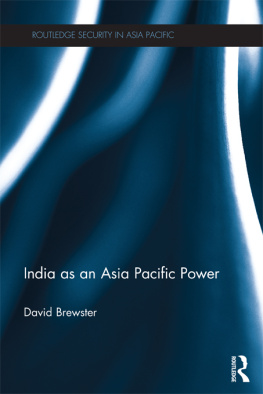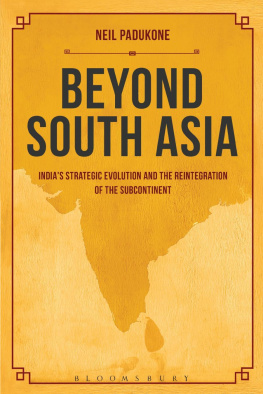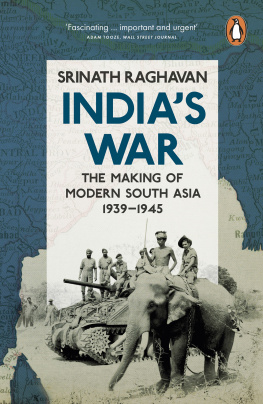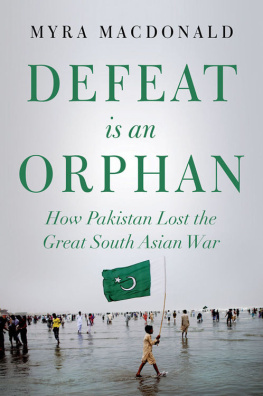The Aeroplane and the Making of Modern India

Great Clarendon Street, Oxford, ox2 6dp,
United Kingdom
Oxford University Press is a department of the University of Oxford. It furthers the Universitys objective of excellence in research, scholarship, and education by publishing worldwide. Oxford is a registered trade mark of Oxford University Press in the UK and in certain other countries
Oxford University Press 2022
The moral rights of the author have been asserted
First Edition published in 2022
Impression: 1
All rights reserved. No part of this publication may be reproduced, stored in a retrieval system, or transmitted, in any form or by any means, without the prior permission in writing of Oxford University Press, or as expressly permitted by law, by licence or under terms agreed with the appropriate reprographics rights organization. Enquiries concerning reproduction outside the scope of the above should be sent to the Rights Department, Oxford University Press, at the address above
You must not circulate this work in any other form and you must impose this same condition on any acquirer
Published in the United States of America by Oxford University Press
198 Madison Avenue, New York, NY 10016, United States of America
British Library Cataloguing in Publication Data
Data available
Library of Congress Control Number: 2022943059
ISBN 9780192864208
eISBN 9780192679192
DOI: 10.1093/oso/9780192864208.001.0001
Links to third party websites are provided by Oxford in good faith and for information only. Oxford disclaims any responsibility for the materials contained in any third party website referenced in this work.
For my mother
Sajidabanu Iqbal
Acknowledgements
Reading acknowledgements to gain insights into the human being behind an otherwise impersonal piece of academic writing has always been one of my favourite guilty pleasures. Writing acknowledgements of my own I am certain will be an even greater pleasure. My deepest thanks are due to Dr Yasmin Khan, who took a leap of faith in agreeing to supervise the doctoral thesis from which this book has emerged. Her ability to provide insightful feedback for very long pieces of writing in very short periods of time has always surprised me and her words of encouragement have proven to be one of my greatest sources of strength. Special thanks are also due to Dr Radhika Singha, my MPhil supervisor, who first suggested that I work on Indian aviation. Without her unstinting support and her emphasis on academic rigour this text might never have come into existence. I would also like to express my sincere gratitude to Dr Robert Johnson, who co-supervised my doctoral work, for bearing with my many demands on his time. David Arnold and Rosalind OHanlon acted as DPhil examiners and provided useful advice on improving the text.
A number of professors have contributed to my development as a scholar including Dr Janaki Nair, Dr Faisal Devji, Dr Aditya Mukherjee, Dr Rudra Chaudhury, and Dr Bernard DSami. Dr Mahesh Rangarajan encouraged me to begin working on publication. As MPhil examiner, Dr Srinath Raghavan predicted from a very early point that my research would one day take the form of a book. His support over the years has been invaluable. I remain especially deeply indebted intellectually to Dr M.S.S. Pandian, whose passing I continue to mourn.
The writing of this book has been made possible by the kindness of absolute strangers, the donors behind the Felix Scholarship, which funded my doctoral studies. I was also exceedingly fortunate to receive a Royal Historical Society doctoral fellowship which I held at the Institute of Historical Research. Extra funding was received from the Frere Exhibition for India studies and the St Edmund Hall writing up grant. A Ministry of Minority Affairs Fellowship from the Government of India helped fund my MPhil research, which forms the foundation for the present work. Krea University allowed me the time and provided me funding necessary to prepare my research for publication.
This book has depended on the services of archivists in both India and the United Kingdom, to all of whom I am deeply grateful. I wish to thank Sq. Ldr. Rana Chhina, perhaps the foremost expert on the history of the Indian Air Force, for advice, encouragement, and most of the photographs in this book. Special thanks are due also to Dr Narendra Yadav from the Interservices History Division archives of the Indian Ministry of Defence. Though relations with archivists in some of the larger archives have necessarily been less personal, because of their size, I must express my thanks to the staff of the British Library, the Royal Air Force Museum, the Tata Central Archives, and the National Archives. The staff at the Bodleian Education Library especially have my grateful appreciation for cheerfully putting up with me for the three years when I lived thirty metres from the library.
Thanks, are also due to Mr J.R. Nanda who in addition to providing me with access to the Harjinder Singh papers also provided several images for this thesis free of cost from his private collection. I would also like to extend my gratitude to Mrs Anuradha Reddy, whose generous advice and extensive collection have served to fill many gaps in my own understanding of Indian aviation. Jagan Pillarisetti too has materially helped this work by providing some extremely rare images for this book at very short notice. Krishna Shekhawat gathered archival material from the Mehrangarh Museum Archives. Nandini Ganguli and the team at OUP provided timely support and the two anonymous reviewers they chose provided me with excellent feedback. They have done their best to save me from any errors, and any mistakes that remain are my own.
C.J. Kuncheria has aided my work for several years now in too many ways to recount both as scholar and as friend. Vipul Dutta, Zahra Shah, Ankita Pandey, and Rafael Pereira helped with earlier drafts of this work. John Mathew, Mahmood Kooria, and Aparajith Ramnath advised me on the intricacies of book publication. Shyama Rajendran and Ramachandra Guha provided important feedback while the manuscript was under revision. Antony Julian, Sonia Kurup, Akshi Singh, Radha Kapuria, Gayatri Nair, Rashmi Singh, Joachem Mowinckel, Amal Sasikumar, Naveen Richard, and David Clarence opened their homes to me while I was visiting archives. Priyasha Mukhopadhyays advice on writing and funding has been crucial. The generous friendship of Lipika, Priya, Claudia, Kalpita, Soumyajit, Gayatri, Bethany, Debak, Dirk, Kapil, Abdul, Parigya, Akash, Niyati, Harsha, and Abhilasha, has sustained me through the often gruelling process of writing. Uttam Kandregula has my everlasting gratitude for acting as my mentor for the past decade and teaching me to have faith in myself.
I would also like to thank my extended Tamil-Marathi-Parsee-Turk family for their love and support, even if I have not always explained what it is I do very clearly to them. I would also like to extend my sincere thanks to Theophilus Joachim, whose family provided me with a home away from home in Boston, England. Nazifa Ahmed, my wife, has filled my life with love and laughter. Her help with map making and formatting constitutes only a small fraction of her contributions to this book.
Tom Varkeys generous support put me through college and propelled me from Ooty to Oxford. Words do not convey my deep thanks to Thomas and Sunita Varkey.
Everything I am and everything I will ever be I owe to my mother, Sajidabanu Iqbal, a single mother and a school teacher. Her courage and optimism in the face of even lifes greatest difficulties is both a lesson and an inspiration. It is to her that I dedicate this book with pride.

